It's a topic we've discussed more than once: The supposed conflict among the Imagineers over the question of whether the Haunted Mansion should be funny or frightening (Silly vs. Scary, Kooky vs. Spooky, Light vs. Fright).
I've also given my own opinion more than once. I think the "conflict" has been exaggerated. Scary vs. Silly makes for a good—suspiciously good—Disneyfied version of history, and since it has long been the official line, it does not surprise or particularly impress me that the Imagineers have routinely cited Silly vs. Scary as a key (or the key) for explaining the fits and starts that dragged out the ride's development and for understanding the odd amalgam of moods in the finished ride. It's frequently the case that if you repeat something often enough you may jolly well begin to actually believe it.
There are two reasons for bringing up the topic again. First, some new materials have surfaced which really should be part of that particular conversation. They shed additional light on the thinking of X Atencio and—less directly—of Claude Coats, both of them supposedly strong advocates of the scary approach. Secondly, we're soon going to be taking a long look at Marc Davis's contributions to the Haunted Mansion, taking advantage of the wealth of new material that came to light in 2019, and as Marc is considered the chief proponent of the funny approach, inevitably the Silly vs. Scary controversy is bound to crop up in that discussion at some point, so that gives us another reason to briefly revisit the topic beforehand.
Can You Spell Kooky With an X?
As we know, Atencio occasionally made remarks to the effect that he preferred the scary approach, and as we have seen, it is easy enough to trot out spine-chilling concept art from X. I might point out, however, that the genuinely horrific artwork he produced was all part of a single series, the "one-eyed black cat" concept, always identifiable by the evil eye present somewhere in the background:
Without that series, you do have some creepy stuff from X, but nothing really frightening (with the possible exception of the Man in the Web). We have also seen that some of X's stuff is much more light-hearted. Even his take on the hanging ghost host is surprisingly cartoonish, meant to amuse rather than frighten. No evil eye in sight.
©DISNEY
The point here is that the man who wrote this piece clearly recognized that the ride needed to be silly as well as scary. To X, like everyone else, it was a matter of finding the right balance:
"We had two schools of thought—one group wanted it a little bit scary, and another wanted it a little more lighthearted. Walt wanted it to be funny—he didn't want to scare the hell out of people! He wanted to just have a good, Halloween-type show. He was very particular on the feeling of the audience that he wanted; he wanted to frighten them, but he didn't want to scare them to death, you know? So that's how they decided. John Hench and Dick Irvine [the Imagineers' immediate bosses], they said to us, 'Let's move in that direction' " (MDIHOW 340).
What all of that really amounted to was sticking with Ken Anderson's original formula, dating back to 1957-58. As Jason Surrell notes, one reason Ken was probably chosen by Walt for the project in the first place is that he had already demonstrated in the Fantasyland dark rides his knack for combining "fear with enjoyment" (Surrell, Haunted Mansion 2003 and 2009 p 14; 2015 p 12).
Campy Claude
It's hard to imagine Claude Coats actually quarreling with anyone. By all counts, he was as amiable and agreeable as they come. Coats too is regularly assigned to the scary camp, not because of things he said or wrote but because his acknowledged contributions to the Mansion are creepy and atmospheric. He gets much of the credit for the eerie first half of the ride, where—we are told—there is nothing silly or funny except for Marc Davis's macabre stretching portraits. Claude was a background painter, a stage designer, a creator in this case of moody and sinister environments, like the Corridor of Doors.
The problem is that settings are not enough. In many cases you cannot tell if you're in kookyland or spookyland until the characters show up, and Claude seemed happy enough to leave that part to Marc. What do I mean? Imagine, for a moment, that you are back in the '60s and know nothing at all about The Munsters TV show but have wandered onto its sets on a day when no one is around. Is there anything there to suggest that this is the stage for an ultra-campy, screwball comedy?
Nope, you could be on the set of a classic, 1930's Universal horror picture. No one would seriously argue that the Munsters' art director wanted the show to be scary but the show writers overruled him and went with silly. I suppose someone might argue that the cobwebbed, Frankenstein look is too picture perfect for serious horror, and it could be claimed that this in itself is a tipoff. It's a point, I allow it. And if we look at the Munsters' fraternal twin, The Addams Family, we find there a similarly creepy, Victorian, gothic look overall, but in this case there are some obvious sight gags thrown in to tell you it's a goof.
Right. Well. Let's take another look at what is arguably the Mansion's scariest environment,
the Corridor of Doors. Do we see anything there hinting that all of this may in fact be camp?
WDW Sampler
Before Elvira, before the Carolyn Jones Morticia, there was Vampira. As Jeff also notes in the link above, she referred to herself at least once as a "ghostess" and promised to supply "hot and cold running chills." Lotta smoke coming outta that gun. And note that it was show writer X Atencio who incorporated that exact language into his HM script already by 1968, so once again we see how someone in the scary camp nevertheless did not hesitate to draw from cheeseball source material.
And let's not overlook the fact that the COD is also home to the so-called "family portraits," which might seem to some more like something
from The Munsters or The Addams Family (or the set of The Vampira Show) than anything you'd see in a straight, no-nonsense horror setting.
Disneyland
[Edit Nov 22] As Imagineer999 has reminded me in the Comments section, the "family portraits" did not appear in the Florida Mansion until the "rehaunting" in 2007, and someone could argue from this that Claude Coats was indeed resistant to including anything so campy in the Orlando COD, where he had greater creative control. Unfortunately, that argument leaves us without any explanation for the inclusion of the Tomb Sweet Tomb sampler, which has always been in the Florida version just as it has been in the California original. Unlike the portraits, that prop is unambiguously cheesy.
I have to admit that I've never really liked the TST sampler. Maybe it's because it can only be explained as schlocky, camp horror, whereas the "family portraits" can be interpreted as ghostly manipulations intended to genuinely freak you out, changing portraits that are no longer bothering to change back. And of course, they are faithful reproductions of ghostly visages yet to appear, as pop-ups in the attic (pre-Constance) and in the graveyard, and those pop-ups are arguably among the scariest apparitions in the Mansion, so even if they're a bit cheesy, we might be making a mistake if we try to simply file them under "funny."
"The Kook Spookin' Song" and Vampira's "Tomb Sweet Tomb" sampler are more grist for the mill,
more evidence (in my book) that the Imagineers all wanted both fear and fun in the Haunted Mansion.
If they disagreed at times, I think it was simply a matter of balance, of fine-tuning that mixture.
more evidence (in my book) that the Imagineers all wanted both fear and fun in the Haunted Mansion.
If they disagreed at times, I think it was simply a matter of balance, of fine-tuning that mixture.
*****************

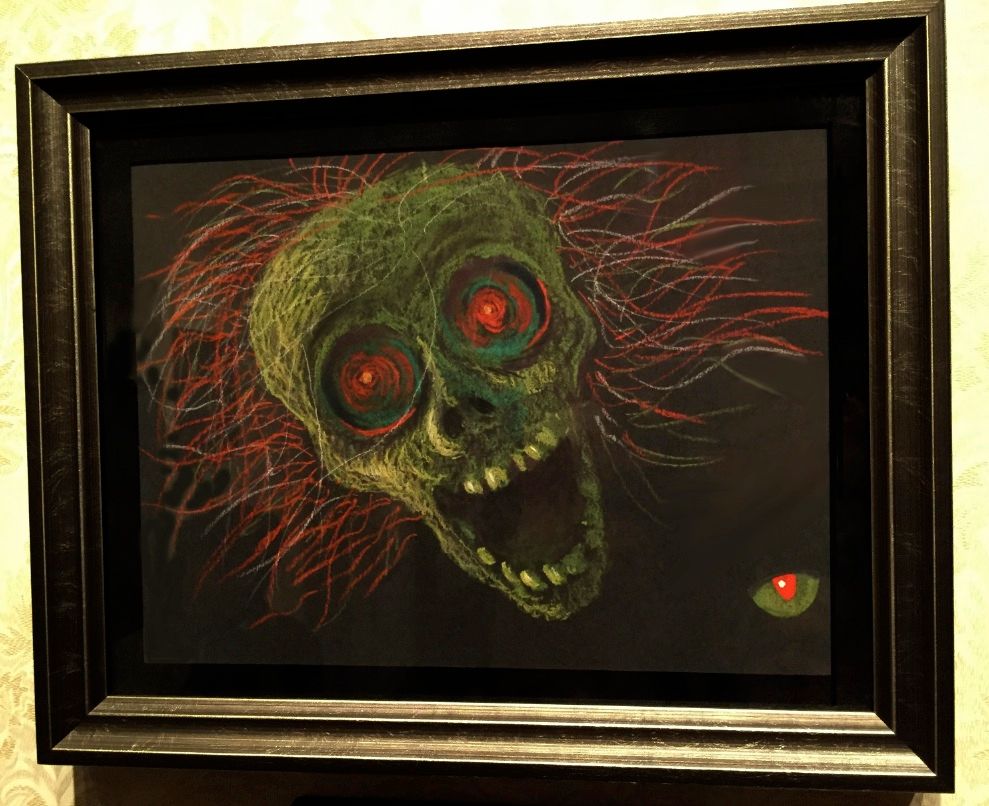
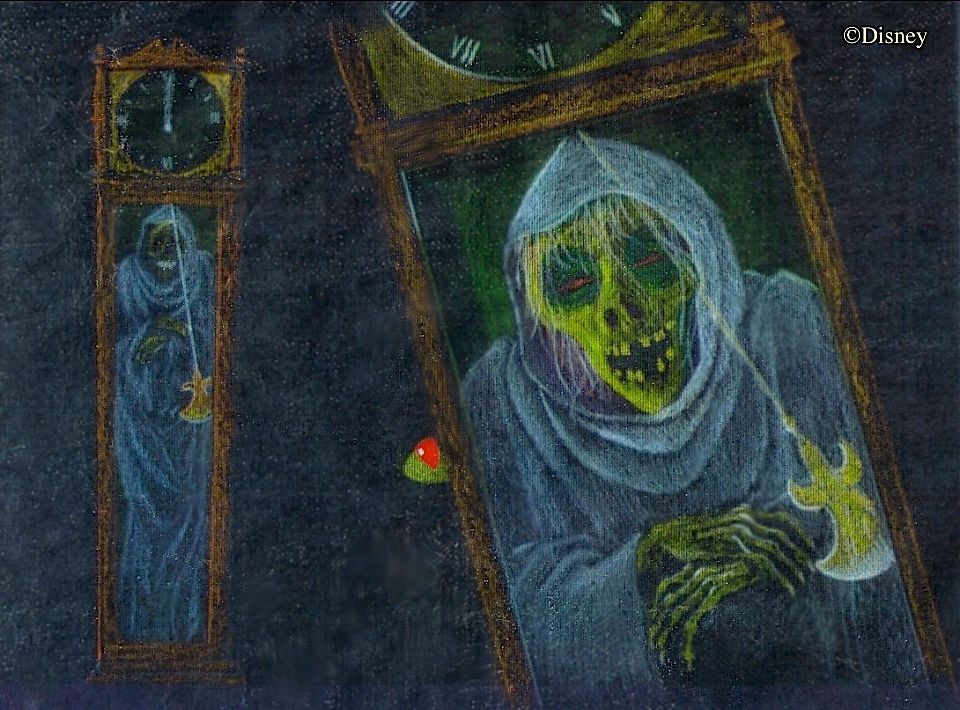
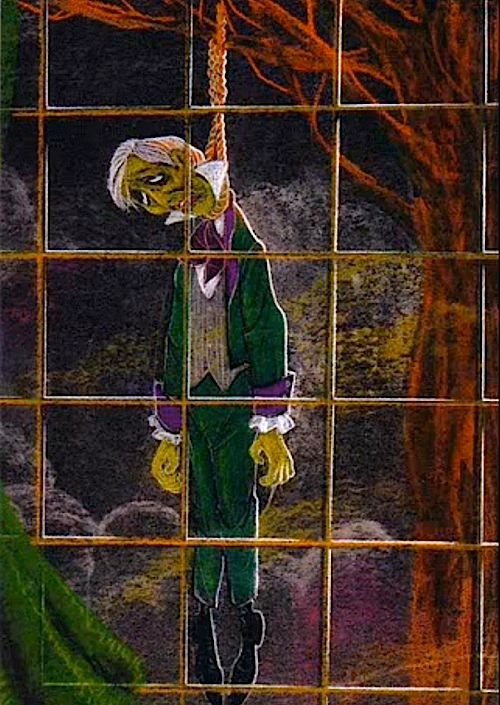




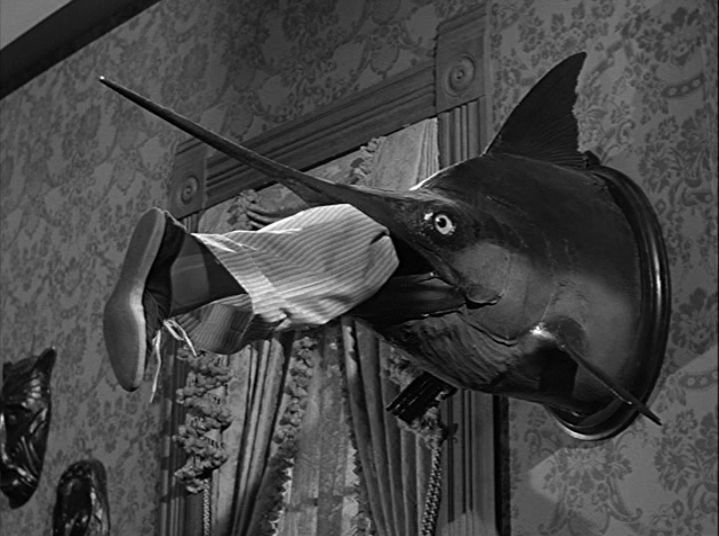

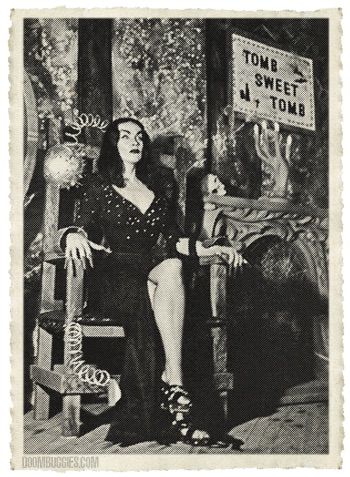
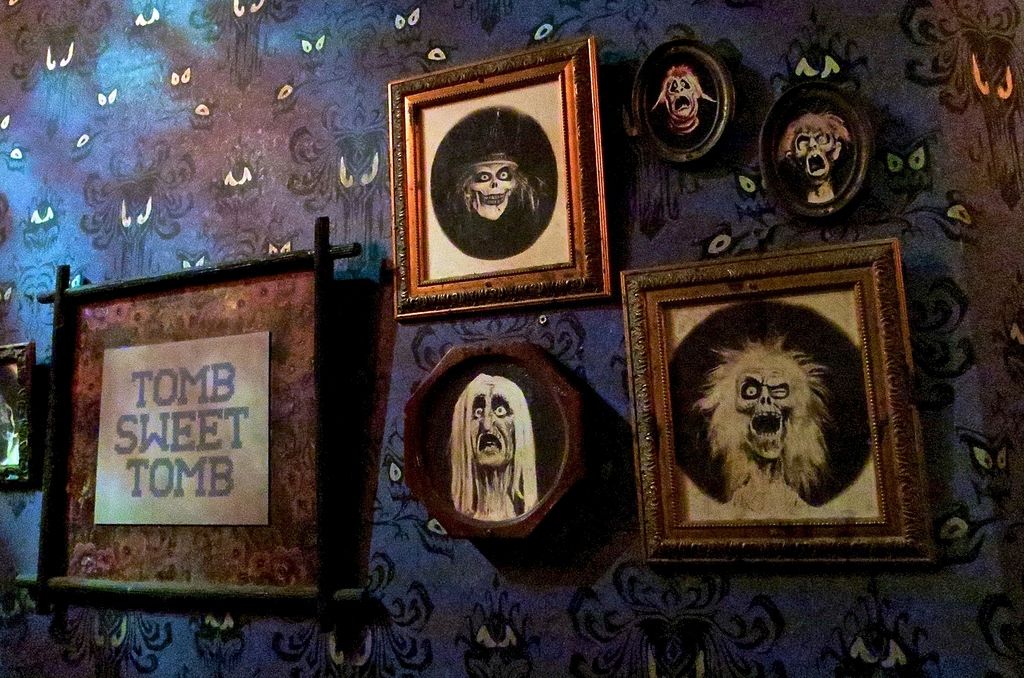
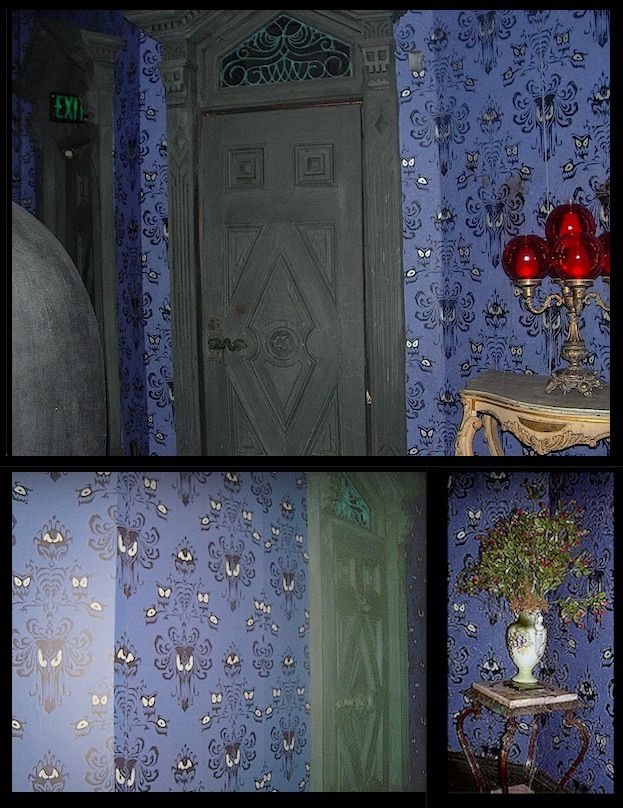





I agree that the balance was always meant to be there. Even if you look at the earliest treatments, gags such as "Harry the Arm" give it away pretty obviously. I've never thought the "conflict" held up development, but, rather, I've always blamed it on the World's Fair. I do think that maybe Marc Davis' strong personality might have caused some push back from the other imagineers, that might have grown into the silly/spooky story, but that's just a theory on my part.
ReplyDeleteThe cat eye looks like nothing so much as a martini olive.
ReplyDeleteJG
When you stare at them for too long, sure, the Family Portraits look pretty goofy, but as a kid getting quick glimpses of these corpse-like ghoul mugs, I'd say they're pretty scary. Especially the "Hag" model, who unlike most of her brethren looks genuinely anguished herself. That helps; no matter how you slice it, having your monster be itself grinning tends to lighten the mood ever so slightly. But I digress. The point is, the Portraits are sillier than they are scary to a grown-up, but to an 8-year-old, I'm not so sure. Similarly, its features may be a little exaggerated, but that rotting hanging corpse behind the window in that Atencio concept art you ascribe to the silly side, it would still give kids nightmare, methinks.
ReplyDeleteAlso, while the phrase "changing portraits that are no longer bothering to change back" is startling, I still think the best interpretations of the Family Portraits is that they are part and parcel of the "retirement home for spooks who came to haunt here of their own accord"; it's a gallery of the current residents, not twisted versions of people who ever lived in the house.
Consider that they depict ghosts whom you come across "in the ectoplasm" as residents of the Mansion later on. Yet even if you grant that more ghosts in the Mansion than just the Host and Constance may have inhabited it in life (and that's already a very questionable proposition IMO), that surely wouldn't include the graveyard Pop-Ups so prominently featured in the Portraits.
Interesting thoughts. The fact that they are the same faces as the popups is a point well taken.
DeleteI always had a more pragmatic view of the COD portraits. I just figured they had the test pics of the popups and someone liked them enough to frame them and use them.
DeleteI think you may be right that the photos started out that way, but they also did quite a bit of tinkering with the photos. I think the black derby on the HBG head is airbrushed over the photo of him wearing the crown. You could argue that all of them were created as they were trying out different "looks" for the pop up heads, or you could argue that they took the existing, rather small number of test photos and played around with them to create a variety of "family portraits."
DeleteThe family portraits were originally not in the Orlando mansion. They were added during the 2007 refurbishment. Their presence doesn't bother me, but I'd prefer they still be left out. It made Orlando's mansion more unique and allowed us to focus more on the doors, and their absence made the CoD more mysterious.
ReplyDeleteI knew they added quite a lot of them in 2007, but I thought they had some before that.
DeleteAh yes, I believe you correct. They were only added to the Orlando HM in 2007. I'll have to make some changes in the post. Thanks.
DeleteYou're welcome! And yes, Orlando has always had the Tomb Sweet Tomb prop. Though in 2007, the original prop was replaced by a smaller one in what I strongly assume was an attempt to make the Orlando mansion more like Anaheim's, and to prove this they surrounded the new prop with the family portraits. For a while we didn't know what happened to the original prop but it turns out that Jason Surrell had it in his private collection after the refurb. He recently donated it to Van Eaton Galleries' upcoming auction. It is going for $5,000 to $7,000 dollars.
DeleteAs chance would have it, the picture of the sampler I'm using in the post is from the Van Eaton catalogue.
Deletehello, I just wanted to state that i am loving the effect your retirement is having on frequency of posts. I truly enjoy the thought and detail put into each subject, thank you for your time.
ReplyDeleteReal people and events are nuanced. Logically, they all probably wanted a balance of scary and silly. But it's so much easier to retell if you exaggerate to the extremes. Then to top it all off, you've got Disney portraying the simplified story as "official."
ReplyDeleteYep on all counts.
DeleteI suppose the "Tomb Sweet Tomb" could have been embroidered by a living resident in some past era who had a Roderick-Usher-type attitude toward their oppressive house. But that's just picking imaginary nits.
ReplyDeleteBut would ever such as they describe their abode as "sweet"?
DeleteIrony?
DeleteThe Ushers? No sense of humor at all, not even enough for a bitter jest.
DeleteYeah, definitely no fun at parties...
Delete